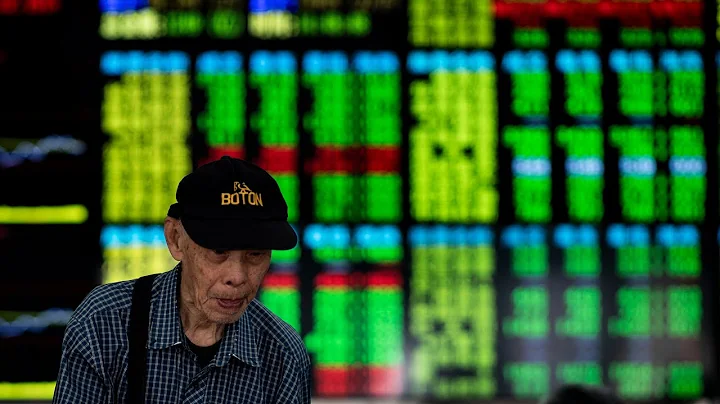
This article is an original article of Sina Hong Kong stocks , welcome to reprint! Search "Sina Hong Kong Stocks" on Baidu, or click to read the original text to download "Sina Hong Kong Stock Connect" to seize the great investment opportunities in Hong Kong stocks!
This afternoon, the official website of the China Insurance Regulatory Commission released a news. The article stated that recently, the China Insurance Regulatory Commission issued the "Regulatory Caliber for Insurance Funds to Participate in the Shanghai-Hong Kong Stock Connect Pilot" (hereinafter referred to as the "Regulatory Caliber"), marking that insurance funds can participate in the Shanghai-Hong Kong Stock Connect. Pilot business.

The China Insurance Regulatory Commission said:
The "Regulatory Standards" require insurance institutions to invest in Hong Kong Stock Connect stocks to follow the principles of prudence and safety, strengthen internal control management, establish and improve relevant systems, and deploy professionals to effectively prevent market risks and investment risks. The main contents include: . First, clarifies that insurance institutions that directly carry out Shanghai-Hong Kong Stock Connect stock investments must have stock investment capabilities. Insurance institutions that do not have stock investment capabilities should entrust qualified investment managers to carry out operations; . Second, clarifies that insurance assets Portfolio insurance asset management products initiated and established by management institutions can invest in Southbound Connect pilot stocks; and clarify that insurance institutions should include the book balance of investment in Southbound Connect stocks in the calculation of equity assets, and clarify that insurance asset management institutions initiate portfolios Requirements for account opening, investment transactions, clearing and accounting when investing in Shanghai-Hong Kong Stock Connect stocks with insurance-like asset management products.
In 2007 and 2014, the China Securities Regulatory Commission issued the "Interim Measures for the Management of Overseas Investment of Insurance Funds" and the "Implementation Rules of the Interim Measures for the Management of Overseas Investment of Insurance Funds", allowing insurance institutions to invest in Hong Kong stocks and other equity assets in developed markets. This time, insurance funds are allowed to participate in the Shanghai-Hong Kong Stock Connect pilot, which further increases the investment methods for insurance funds to participate in the Hong Kong stock market. First, will help insurance institutions choose investment targets more flexibly and ease the pressure of asset allocation. Second, will It will help insurance institutions use both domestic and overseas markets to optimize the asset allocation structure and prevent and resolve investment risks; and third, will help insurance institutions increase investment returns and serve the development of the main insurance business.
Super good news will bring trillions of funds into Hong Kong stocks!
CICC Wang Hanfeng said that this is another important type of mainland institutional investors that can participate in Shanghai-Hong Kong Stock Connect and continue to support the performance of Hong Kong stocks. After it was previously clear that public funds could participate in the Shanghai-Hong Kong Stock Connect to invest in Hong Kong stocks, there are now nearly 50 public fund products that can invest in Hong Kong stocks through the Shanghai-Hong Kong Stock Connect. Today, the China Insurance Regulatory Commission's "Regulatory Criteria" allows insurance funds, an important institutional fund in the mainland, to directly invest in Hong Kong stocks through Shanghai-Hong Kong Stock Connect, which is good for the short-term sentiment and capital of Hong Kong stocks.
Previously, mainland insurance industry funds could only use the QDII (Qualified Foreign Institutional Investor) quota for overseas investment. This time, the regulatory authorities have relaxed the rules, allowing insurance funds to use the Shanghai Stock Connect to buy Hong Kong stocks. Industry insiders analyze that if the measures are implemented, Trillions of yuan of funds will pour into Hong Kong stocks, and the effect is comparable to that of public funds being allowed to use Shanghai-Hong Kong Stock Connect last year. According to earlier media reports, as of the end of last year, overseas investment in the insurance industry was approximately US$36 billion, accounting for only about 2% of total assets, while the regulatory limit for overseas investment is 15% of total assets.
CICC Wang Hanfeng said that based on our current communication with various investors, in addition to QDII channels, some insurance companies may have indirectly invested in Hong Kong stocks through the purchase of public fund products or other forms through Shanghai-Hong Kong Stock Connect, but the scale has not yet been determined. Public data can be counted. At present, the balance of funds used in the insurance industry is about 12.5 trillion, of which the proportion invested in stocks and funds is about 13.7%. Assuming that 10% of the initial investment is distributed to the Hong Kong stock market, the corresponding amount of funds may be about 170 billion yuan. In recent years, China's premium income has been increasing at a rate of about 2 trillion yuan per year. Assuming that the new premiums are invested in Hong Kong stocks in the same proportion, the potential incremental funds brought to Hong Kong stocks every year are about 30 billion yuan.
At the end of March last year, the China Securities Regulatory Commission announced the "Guidelines for Publicly Offered Securities Investment Funds to Participate in Shanghai-Hong Kong Stock Connect Transactions", which clarified that public funds do not need to go through the Qualified Domestic Institutional Investor (QDII) mechanism and can directly raise funds through the "Shanghai-Hong Kong Stock Connect" "Mechanism to invest in Hong Kong stocks.This policy directly triggered the "big era" of Hong Kong stocks last year. On April 8, after the Qingming Festival, Hong Kong stocks soared 3.8%, and rose again by 2.7% on April 9. Since then, they have continuously tested the top, starting a magnificent bull market for Hong Kong stocks. , the Hang Seng Index reached a high of 28588 points.

The trend of Hong Kong stocks last year
Which Hong Kong stocks are favored by insurance funds?
Combined with the relevant ongoing research and observations of insurance institutions, there are four types of Hong Kong stocks that are highly attractive to insurance funds pursuing stable absolute returns, namely: A+H shares have discount and premium advantages, scarcity advantages, low valuations and high Dividend yield stocks , bond-like stocks.
"The Hong Kong stock market has a number of leading companies with cheap valuations and high quality, especially large and medium-sized targets, which are more favored by insurance funds. In addition, we are also interested in growth stocks with fast profit growth in Hong Kong stocks, especially A shares We believe that the next two to three years will be a good time to get involved in the scarce varieties that does not have.” For example, the person in charge of an insurance institution said that their stock selection criteria mainly include the following: emerging industries and future market size. Large space; leader in the subdivided industry, but has not formed a monopoly position, with room for expansion of both market space and market share; high gross profit, certain entry barriers, and low competitive pressure; good performance fundamentals, with an average of 30% for three consecutive years The possibility of high growth above %.
CICC recommends that investors pay attention to four main lines: 1) Mainland investors in the stocks covered by the Shanghai-Hong Kong Stock Connect southbound may prefer stocks whose valuations are still cheaper than similar A-share stocks; 2) Hang Seng Securities may be included in the Shenzhen-Hong Kong Stock Connect. Some A-share investors in the index may like constituent stocks with better quality; 3) Brokers (especially local brokers in Hong Kong), exchanges and asset managers; 4) The price difference between A/H listed companies is large The H shares company.
Insurance funds have been heavily deployed in Hong Kong stocks this year.
Since this year, insurance funds have been heavily deployed in Hong Kong stocks. In addition to being cornerstone investors and participating in private placements, they have also increased their holdings of Hong Kong stocks through the secondary market.
Among the eight cornerstone investors of Everbright Securities H shares, there are three insurance institutions. China Life, The Prudential Insurance Company of America and Smithsonian Life Insurance invested US$80 million (approximately HK$620 million), US$30 million and US$20 million respectively.
CDB Leasing (0160 6, HK) offering information shows that China Re Group subscribed 3. 70.8 billion shares. After China Banking Leasing was listed on July 11, China Re held 10.87% of the shares and spent HK$740 million for this purpose. China Life and China Re Group, as cornerstone investors, have nearly HK$1.4 billion in capital.
On July 13, China Life spent HK$970 million to increase its holdings of 486.7 million shares in Harbin Bank (06138, HK), with its shareholding ratio increasing from 13. 12% increased to 16.10%. On July 7, China Re Group also spent HK$2.46 million to increase its holdings of 3 million shares in Hengdeli (03389, HK), increasing its shareholding ratio from 5.96% to 6.02%.
html On May 19, China Life increased its holdings of Harbin Bank H shares (06138, HK) by 120.283 million shares at an average price of HK$2 per share over the counter at a cost of HK$240 million. As of yesterday, China Life Insurance's shareholding ratio increased from 9.14% to 13.12%.On February 19 this year, Huaxia Life Insurance entered Harbin Bank and purchased 276 million shares over-the-counter for HK$2 per share, with a total cost of HK$552 million and a shareholding ratio of 9.14%.
html On May 18, China Re increased its holdings of Beijing Jingneng Clean Energy Power H shares (00597, H K) at HK$2.356 per share. It increased its holdings by 10 million shares on the market at a cost of HK$23.56 million. At this point, China Re's shareholding ratio in the stock increased from 4.88% to 5.3%. However, among these holdings, 116 million shares are held directly, while 08.7 million shares are held in the capacity of 205 (that is, the interest of the controlled corporation). html On May 10, CPIC Group’s shareholding ratio in Brightoil Petroleum (00933, H K) increased to 9.16%. html On May 5, Ping An’s shareholding ratio in Luye Pharmaceutical (02186, H K) increased to 13.91% from 11.53%.




















